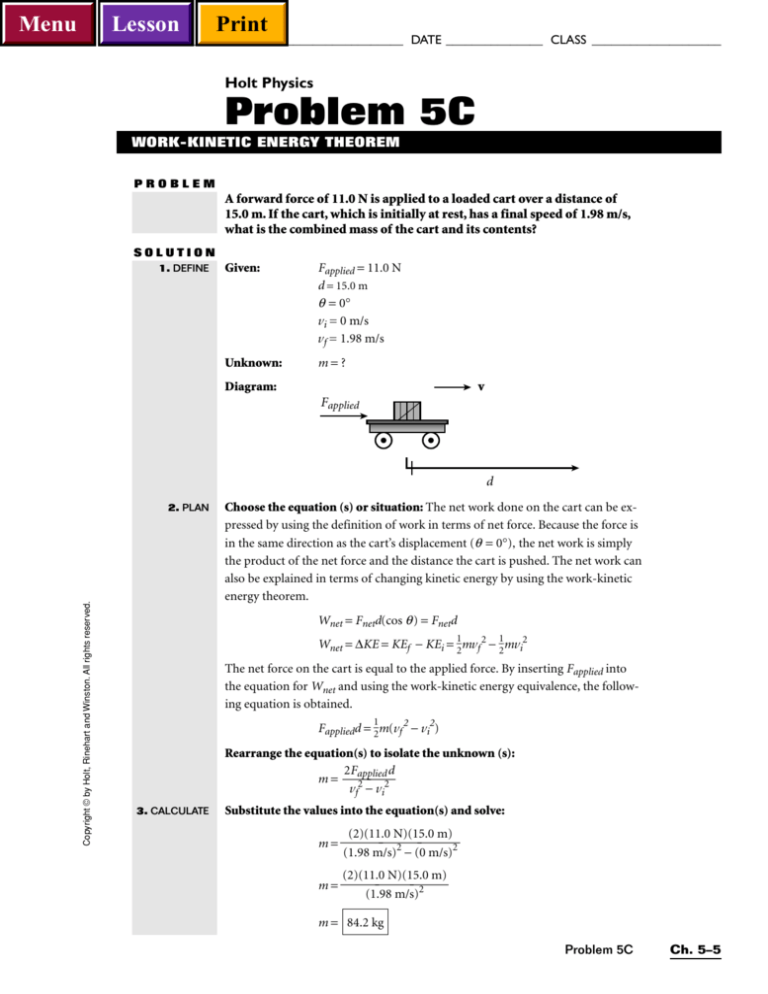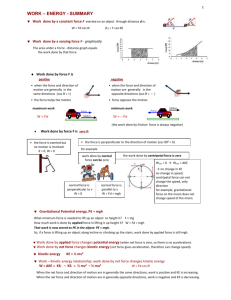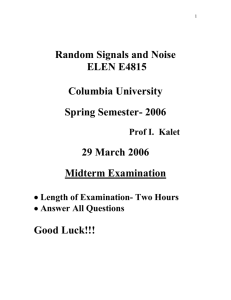
Menu
Lesson
Print
NAME ______________________________________ DATE _______________ CLASS ____________________
Holt Physics
Problem 5C
WORK-KINETIC ENERGY THEOREM
PROBLEM
A forward force of 11.0 N is applied to a loaded cart over a distance of
15.0 m. If the cart, which is initially at rest, has a final speed of 1.98 m/s,
what is the combined mass of the cart and its contents?
SOLUTION
1. DEFINE
Given:
Fapplied = 11.0 N
d = 15.0 m
q = 0°
vi = 0 m/s
vf = 1.98 m/s
Unknown:
m=?
v
Diagram:
Fapplied
d
Copyright © by Holt, Rinehart and Winston. All rights reserved.
2. PLAN
Choose the equation (s) or situation: The net work done on the cart can be expressed by using the definition of work in terms of net force. Because the force is
in the same direction as the cart’s displacement (q = 0°), the net work is simply
the product of the net force and the distance the cart is pushed. The net work can
also be explained in terms of changing kinetic energy by using the work-kinetic
energy theorem.
Wnet = Fnetd(cos q) = Fnetd
1
1
Wnet = ∆KE = KEf − KEi = 2mvf 2 − 2mvi2
The net force on the cart is equal to the applied force. By inserting Fapplied into
the equation for Wnet and using the work-kinetic energy equivalence, the following equation is obtained.
1
Fappliedd = 2m(vf 2 − vi2)
Rearrange the equation(s) to isolate the unknown (s):
2Fapplied d
m=
vf2 − vi2
3. CALCULATE
Substitute the values into the equation(s) and solve:
(2)(11.0 N)(15.0 m)
m =
(1.98 m/s)2 − (0 m/s)2
(2)(11.0 N)(15.0 m)
m =
(1.98 m/s)2
m = 84.2 kg
Problem 5C
Ch. 5–5
Menu
Lesson
Print
NAME ______________________________________ DATE _______________ CLASS ____________________
4. EVALUATE
Note that the form of the equation is equivalent to Newton’s second law, with acceleration given by the kinematic equation.
vf2 − vi2
a =
2d
ADDITIONAL PRACTICE
1. A hockey puck with an initial speed of 8.0 m/s coasts 45 m to a stop
across the ice. If the force of friction on the puck has a magnitude of
0.12 N, what is the puck’s mass?
2. A meteoroid is a small fragment of rock that orbits a planet or the sun.
When a meteoroid enters a planet’s atmosphere, it most likely will burn
up entirely, glowing brilliantly as it does so. It is then referred to as a
meteor. Consider a meteoroid that has an initial speed of 15.00 km/s
when it enters the thin upper region of Earth’s atmosphere. Suppose
this meteoroid encounters a force of resistance with a magnitude of
9.00 × 10−2 N, so that after it travels 500.0 km parallel to Earth’s surface
the meteoroid’s speed is 14.97 km/s. Assume that the meteoroid does
not lose any mass as its temperature increases, and that the change in
the gravitational potential energy is negligible. What is the mass of the
meteoroid?
3. A car moving at a speed of 48.0 km/h accelerates 100.0 m up a steep
hill, so that at the top of the hill its speed is 59.0 km/h. If the car’s mass
is 1100 kg, what is the magnitude of the net force acting on it?
5. The force that stops a fighter jet as it lands on the flight deck of an
aircraft carrier is provided by a series of arresting cables. These cables
are attached to large springs that stretch enough to keep the plane from
slowing down too suddenly. Suppose a Hornet jet traveling with an
initial speed of 2.40 × 102 km/h lands on the flight deck, where it is
brought to rest by a net acceleration of magnitude 30.8 m/s2. If the jet’s
mass is 1.30 × 104 kg, how far does the jet travel during its deceleration?
6. A 50.0 kg parachutist falls at a speed of 47.00 m/s when the parachute
opens. The parachutist’s speed upon landing is 5.00 m/s. How much
work is done by the air to reduce the parachutist’s speed?
Ch. 5–6
Holt Physics Problems Bank
Copyright © by Holt, Rinehart and Winston. All rights reserved.
4. A 450 kg compressor slides down a loading ramp that is 7.0 m long. Initially at rest, the compressor’s speed at the bottom of the ramp is 1.1 m/s.
What is the magnitude of the net force acting on the compressor?
Menu
Lesson
Print
NAME ______________________________________ DATE _______________ CLASS ____________________
7. The giant sequoia redwood trees of the Sierra Nevada in California are
said never to die from old age. Instead, an old tree dies when its shallow
roots become loosened and the tree falls over. Removing a dead mature
redwood from a forest is no easy feat, as the tree can have a mass of
nearly 2.0 × 106 kg. Suppose a redwood with this mass is lifted 7.5 m
with a net upward acceleration of 7.5 × 10–2 m/s2. If the tree’s initial kinetic energy is zero, what is the final kinetic energy?
8. An applied force of 92 N is exerted horizontally on an 18 kg box of
books. The coefficient of kinetic friction between the floor and the box
is 0.35. If the box is initially at rest with zero kinetic energy, what is the
final kinetic energy after it has been moved 7.6 m across the floor?
9. A 2.00 × 102 kg iceboat is propelled across the horizontal surface of a
frozen lake by the wind. The wind exerts a constant force of 4.00 ×
102 N while the boat moves 0.90 km. Assume that frictional forces are
negligible and that the boat starts from rest. What is the boat’s final
speed?
Copyright © by Holt, Rinehart and Winston. All rights reserved.
10. A certain firework is made of a small cardboard tube with a mass of
about 20.0 g. When lit, the tube slides 2.5 m across a smooth surface. If
the forward force on the tube is 7.3 × 10−2 N and the coefficient of friction between the tube and the ground is 0.20, what is the tube’s final
speed? Assume the tube is initially at rest.
Problem 5C
Ch. 5–7
Menu
Lesson
Print
Givens
Solutions
6. v = 850 km/h
KE = 9.76 × 109 J
2 KE
(2)(9.76 × 109 J)
m =
=
v2
[(850 km/h)(103 m/km)(1 h/3600 s)]2
m = 3.50 × 105 kg
7. v = 9.78 m/s
KE = 6.08 × 104 J
8. KE = 7.81 × 104 J
m = 55.0 kg
9. KE = 1433 J
m = 47.0 g
1
10. KEA,i = 2KEB
2 KE (2)(6.08 × 104 J)
m =
=
= 1.27 × 103 kg
v2
(9.78 m/s)2
v=
v=
33 J)
2mKE =
47(.20)(×141
0 kg =
247 m/s
−3
1
KEA,i = 2KEB
= 22 mBvB2
vA,f = vA,i + 1.3 m/s
1
m v 2
2 A A,i
KEA,f = KEB
1
(2m )v 2
B A,i
2
mA = 2.0 mB
(2)(7.81 × 104 J)
= 53.3 m/s
55.0 kg
2 KE
=
m
11
1
= 4 mBvB2
1
vA,i2 = 4 vB2, or vB2 = 4vA,i2
1
vA,i = 2 vB
KEA,f = KEB
1
2
mAvA,f 2 = 2 mBvB2
1
1
2
(2mB)(vA,i + 1.3 m/s)2 = 2 mB vB2
1
1
1
(vA,i + 1.3 m/s)2 = 2 vB2 = 2 (4vA,i2) = 2vA,i2
vA,i2 + (2.6 m/s) vA,i + 1.7 m2/s2 = 2vA,i2
Copyright © by Holt, Rinehart and Winston. All rights reserved.
vA,i2 − (2.6 m/s) vA,i − 1.7 m2/s2 = 0
Using the quadratic equation,
m2/s2
2.6 m/s ± (−
8m
2/s2+6.8
2.
6m
/s
)2−4(−
1.
7m
2/s2) 2.6 m/s ± 6.
vA,i = =
2
2
vA,i =
vA,i =
13.6
2.6 m/s ± m2/
s2
2.6 m/s ± 3.69 m/s
2
6.3 m/s
2
= = = 3.2 m/s
2
1
v
2 B
vB = vA,i = (2)(3.2 m/s) = 6.4 m/s
Additional Practice 5C
1. vi = 8.0 m/s
1
vf = 0 m/s
Wnet = Fnetd(cos q) = Fkd(cos q)
d = 45 m
1
2
Fk = 0.12 N
q = 180°
1
Wnet = ∆KE = KEf − KEi = 2 mvf2 − 2 mvi2
m(vf 2 − vi2) = Fkd(cos q)
(2)(0.12 N)(45 m)(cos 180°)
2 Fkd(cos q)
−(2)(0.12 N)(45 m)
=
=
m=
(0 m/s)2 − (8.0 m/s)2
vf2 − vi2
−64 m2/s2
V
m = 0.17 kg
Section Five—Problem Bank
V Ch. 5–3
Menu
Lesson
Givens
Print
Solutions
2. vi = 15.00 km/s
vf = 14.97 km/s
–2
Fr = 9.00 × 10 N
d = 500.0 km
q = 180°
1
1
Wnet = ∆KE =KEf − KEi = 2 mvf 2 − 2 mvi2
Wnet = Fnetd(cos q) = Fr d (cos q)
1
2
m(vf 2 − vi2) = Fr d (cos q)
(2)(9.00 × 10−2 N)(500.0 × 103 m)(cos 180°)
2 Fr d (cos q)
m=
=
(14.97 × 103 m/s)2 − (15.00 × 103 m/s)2
vf 2 − vi2
−(2)(9.00 × 10−2 N)(500.0 × 103 m)
−9.00 × 104 J
m =
=
2.241 × 108 m2/s2 − 2.250 × 108 m2/s2
−9 × 108 m2/s2
m = 1.00 × 10−4 kg
3. vi = 48.0 km/h
vf = 59.0 km/h
d = 100.0 m
m = 1100 kg
q = 0°
1
1
Wnet = ∆KE = KEf − KEi = 2 mvf 2 − 2 mvi2
Wnet = Fnet d (cos q)
1
Fnet d (cos q) = 2 m(vf 2 − vi2)
2
2
(1100 kg)[(59.0 km/h)2 − (48.0 km/h)2](103 m/km)2 (1h/3600 s)2
m(vf − vi )
=
Fnet =
(2)(100.0 m)(cos 0°)
2 d (cos q)
(1100 kg)(3.48 × 109 m2/h2 − 2.30 × 109 m2/h2)(1h/3600 s)2
Fnet =
(2)(100.0 m)
(1100 kg)(1.18 × 109 m2/h2)(1h/3600 s)2
Fnet =
(2)(100.0 m)
Fnet = 5.01 × 102 N
d = 7.0 m
vf = 1.1 m/s
vi = 0 m/s
1
Wnet = ∆KE = KEf − KEi = 2 mvf 2 − vi2
Wnet = Fnetd(cos q)
1
Fnetd(cos q) = 2 m(vf2 − vi2)
2
2
(450 kg)[(1.1 m/s)2 − (0 m/s)2]
m(vf − vi )
(450 kg)(1.2 m2/s2)
= =
Fnet =
(2)(7.0 m)(cos 0°)
2 d (cos q)
(2)(7.0 m)
q = 0°
Fnet = 39 N
5. vi = 2.40 × 102 km/h
vf = 0 km/h
anet = 30.8 m/s2
1
Wnet = ∆KE = KEf − KEi = 2 mvf 2 − vi2
Wnet = Fnet d (cos q) = manet d(cos q)
m = 1.30 × 104 kg
manetd(cos q) = 2 m(vf2 − vi2)
q = 180°
[(0 km/h)2 − (2.40 × 102 km/h)2] (103 m/km)2(1h/3600 s)2
vf 2 − vi2
d =
=
(2)(30.8 m/s2)(cos 180°)
2 anet (cos q)
1
(−5.76 × 104 km2/h2)(103 m/km)2 (1h/3600 s)2
d =
= 72.2 m
−(2)(30.8 m/s2)
V
V Ch. 5–4
Holt Physics Solution Manual
Copyright © by Holt, Rinehart and Winston. All rights reserved.
4. m = 450 kg
Menu
Lesson
Print
Givens
Solutions
6. m = 50.0 kg
1
vi = 47.00 m/s
vf = 5.00 m/s
1
Wnet = ∆KE = KEf − KEi = 2 mvf 2 − 2 mvi2
1
1
Wnet = 2 m(vf2 − vi2) = 2 (50.0 kg)[(5.00 m/s)2 − (47.00 m/s)2]
1
1
Wnet = 2 (50.0 kg)(25.0 m2/s2 − 2209 m2/s2) = 2 (50.0 kg)(−2184 m2/s2)
Wnet = −5.46 × 104 J
7. m = 2.0 × 106 kg
Wnet = ∆KE = KEf − KEi = KEf
Wnet = Fnet d (cos q) = manetd(cos q)
d = 7.5 m
anet = 7.5 × 10−2 m/s2
KEf = manet d (cos q) = (2.0 × 106 kg)(7.5 × 10−2 m/s2)(7.5 m)(cos 0°)
KEi = 0 J
KEf = 1.1 × 106 J
8. Fapplied = 92 N
Wnet = ∆KE = KEf − KEi = KEf
m = 18 kg
Wnet = Fnet d (cos q)
mk = 0.35
Fnet = Fapplied − Fk = Fapplied − mk mg
KEf = (Fapplied − mk mg) d (cos q)
d = 7.6 m
= [92 N − (0.35)(18 kg)(9.81 m/s2)](7.6 m)(cos 0°)
2
g = 9.81 m/s
q = 0°
KEf = (92 N − 62 N)(7.6 m) = (3.0 × 101 N)(7.6 m)
KEi = 0 J
KEf = 228 J
9. m = 2.00 × 102 kg
1
1
Wnet = ∆KE = KEf − KEi = 2 mvf2 − 2 mvi2
Fwind = 4.00 × 102 N
Wnet = Fnet d (cos q) = Fwind d(cos q)
d = 0.90 km
1
2
vi = 0 m/s
q = 0°
1
mvf2 − 2 mvi2 = Fwind d (cos q)
2Fwind d (cos q)
+ vi2 =
m
2
f
Copyright © by Holt, Rinehart and Winston. All rights reserved.
(2)(4.00 × 102 N)(0.90 × 103 m)(cos 0°)
+ (0 m/s)2
2.00 × 102 kg
(2)(4.00 × 10 N)(9.0 × 10 m)
v = 2.00 × 10 kg
vf =
2
2
vf = 6.0 × 101 m/s
10. m = 20.0 g
d = 2.5 m
Fforward = 7.3 × 10−2 N
mk = 0.20
vi = 0 m/s
g = 9.81 m/s2
q = 0°
1
1
Wnet = ∆KE = KEf − KEi = 2 mvf 2 − 2 mvi2
Wnet = Fnetd(cos q) = (Fforward − Fk) d(cos q) = (Fforward − mk mg)d(cos q)
1
2
1
mvf 2 − 2 mvi2 = (Fforward − mk mg)d(cos q)
2[(Fforward − mk mg) d (cos q) + vi2]
m
(2)[7.3 × 10 N − (0.20)(20.0 × 10 kg)(9.81 m/s )](2.5 m)(cos 0°) + (0 m/s)
v = 20.0 × 10 kg
(2)(7.3 × 10 N − 3.9 × 10 N)(2.5 m)
(2)(3.4 × 10 N)(2.5 m)
=
v = 20.0 × 10 kg
2.00 × 10 kg
vf =
−2
−3
2
−3
f
−2
f
2
−2
−3
−2
−2
vf = 2.9 m/s
V
Section Five—Problem Bank
V Ch. 5–5







